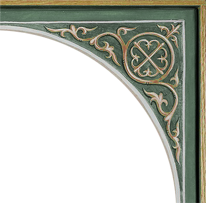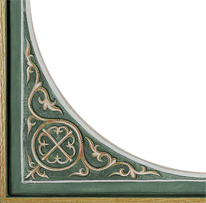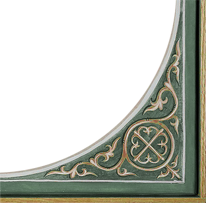The Divine Services of the Orthodox Church Matins - 3
Today we will conclude our examination of the Saturday evening Vigil service. Last Sunday, we made our way to the highlights of the Matins service - the Polyeleos, the Magnification to the feast or saint, and the reading of the bright Resurrection Gospel. As we discussed then, these joyful events help us to understand and emphasize the celebration of the feast or saint being commemorated, as well as the good news that defines Sunday as the day of the resurrection of our Lord Jesus Christ.
After the Gospel reading, the Gospel is carried to the middle of the church, where the faithful will soon have the opportunity to venerate it.
The priest or deacon then intones an intercessory prayer commemorating and calling upon the prayers of all the saints: the Mother of God, John the Baptist, the Apostles, the hierarchs, martyrs, monks, and other saints. As we listen to and call upon this list of the heroes of the faith, we become aware of the long history of sanctity that has graced the Orthodox Church. We realize that there is no separation between the communities of the members of the Church in heaven with the members of the Church on earth. All are gathered together in prayer and praise of God. The only thing which draws a veil separating us is our own attraction to the gravity of sin and worldliness, which blinds us to this glorious spiritual closeness.
We now venerate the Holy Gospel, which lies upon the lectern in the middle of the church. First the clergy and servers will cross themselves and kiss the Sacred Book and the icon that represents the feast or saint being remembered, then all members of the congregation come forward to venerate the Gospel and to receive the anointing with holy oil upon their forehead.
While the people are coming forward to venerate the Gospel and receive the anointing, the Canon begins. The Canon is the name for a series of hymns which are composed to a definite order. A Canon is divided into 9 parts or ‘odes’ and each ode is prefaced with a hymn sung by the choir called an ‘irmos’ which means ‘connection’ or ‘link’. These irmosi hearken back to examples from the Old Testament that link us in some way to the prophecy or Scriptural foreshadowing of the subject of the Canon. For our Sunday Matins service, the primary celebration is, again, the resurrection of Christ – so we hear in the irmosi examples from the Old Testament that foreshadow the coming of Christ, His life and sufferings, and His glorious resurrection and triumph over death.
After the 3rd, 6th, and 9th odes, we have a Small Ectenia – ‘Again and again in peace let us pray to the Lord…’.
Prior to the beginning of the 9th ode, the priest or deacon censes the altar and then comes out to cense the iconostatis, stopping at the icon of the Mother of God. He proclaims, ‘The Theotokos and Mother of Light, let us magnify in song,’ and then he continues with a full censing of the church. The choir begins the Song of the Theotokos, ‘My soul doth magnify the Lord, and my spirit hath rejoiced in God my Savior.’ After each verse of this hymn, we sing, ‘More honorable than the Cherubim, and beyond compare more glorious than the Seraphim, thee who without corruption gavest birth to God the Word, the very Theotokos thee do we magnify.’
Why is it important for us to magnify the Virgin Mary in our Sunday Matins service? Why, if our focus is on the glorious fulfillment of the Messiah and His resurrection from the dead, why do we stop at this point to focus our attention on His mother and to praise her in such lofty terms? It is precisely to give the proper honor and glory to Jesus Christ as God that we proclaim the Virgin Mary as ‘Theotokos’ – which means ‘birth-giver of God’. It was the third Ecumenical Council in the year 431 that condemned the heresies being spread at that time that Christ was not fully God and fully man. In recognizing the true nature of Christ as fully God and fully man, we correctly praise the Virgin Mary as the one ‘who without corruption gavest birth to God the Word.’
Special ‘Hymns of Light’ are then chanted and then we move into the ‘Lauds’ or ‘Praises’. The Praises consist of texts from Psalms 148, 149, and 150 in which all of God’s creation is summoned to glorify Him. ‘Praise ye God in His saints, praise Him in the firmament of His power. Praise Him for His mighty acts, praise Him according to the multitude of His greatness.’
Now we come to the ‘finale’ of the Matins service… the Royal Doors are opened, the lights are illumined, and the priest calls out in triumph, ‘Glory to Thee Who has shown us the light!’ In the monasteries, when a true ‘all night’ Vigil is served, this portion of the service occurs right around the timing of the rising of the morning sun. This is an especially moving and uplifting moment after the long and beautiful night of prayers.
The choir sings the Doxology in which we give thanks to God for the light of day and for His gift of the spiritual Light of Truth, Christ our Lord. The Great Doxology is one of the most beautiful and all-encompassing prayers of the Church in which we again here the all-encompassing prayer of the spiritual Cross which covers and blesses the world: Quoting Fr Victor Potapov again… in this prayer we behold ‘three fundamentally related paths of struggle in pursuit of a Christian life. Upward, toward God in the words of praise, ‘Glory to God in the highest,’ outward toward your neighbor in the words, ‘and on earth peace,’ and downward into the depth of your heart in the words, ‘good will among men.’ Seen together, the thrust of these struggles, upward, outward and downward, form the symbol of the Cross, thereby manifesting the ideal of the Christian life: granting peace with God, peace among men, and peace in the soul.”
It is precisely in this cruciform view of things - upward toward God, outward toward our fellow man, and inward into the depths of our soul – that we embrace the correct priority of things and the hierarchy of self-giving love: God, others, and then ourselves.
The Vigil service began with the silence of creation and proceeded through the prophecies and anticipation of the promise of the coming Messiah. As we moved into Matins, we glorified the arrival of Christ into this world and praised His bright resurrection. We have come now to the conclusion of the Vigil service and to the fullness of the revelation of God to mankind. In the Great Doxology we know and praise God as Father, Son, and Holy Spirit, the Trinity.
The Matins service ends with two final Ektenias and with the final blessing and dismissal from the priest.
Dear brothers and sisters in Christ, if we are intending to receive Holy Communion on Sunday, we should make every effort to attend the Vigil service as the proper spiritual preparation and as the best and most appropriate time to make our confession before receiving the Holy Eucharist.
The evening Vigil service renews us spiritually, prepares us for the coming day of the Resurrection, and gives us the full teaching and glorification of the saints and feasts being commemorated. Let each of us strive to attend the Vigil service as often as we can. I know that our lives are hectic, but the calm and quiet beauty of the Vigil service calls to us as a haven and a rest from the concerns and preoccupations of this world. It is a refreshment for our souls!
May God bless you and grant you the zeal to love the beauty of His House and to worship Him in the fulness of the glory of His Divine Services.
|




